

Mennonites and Mormons in Mexican Culture
“…Liminal Sovereignty examines the lives of two religious minority communities in Mexico, Mennonites and Mormons, as seen through Mexican culture. Mennonites emigrated from Canada to Mexico from the 1920s to the 1940s, and Mormons emigrated from the United States in the 1880s, left in 1912, and returned in the 1920s. Rebecca Janzen focuses on representations of these groups in film, television, online comics, photography, and legal documents. Janzen argues that perceptions of Mennonites and Mormons—groups on the margins and borders of Mexican society—illustrate broader trends in Mexican history. The government granted both communities significant exceptions to national laws to encourage them to immigrate; she argues that these foreshadow what is today called the Mexican state of exception. The groups’ inclusion into the Mexican nation shows that post-Revolutionary Mexico was flexible with its central tenets of land reform and building a mestizo race. Janzen uses minority communities at the periphery to give us a new understanding of the Mexican nation…”
Link to summary
HSBC Highlights Corporate Optimism’s Resilience Over Global Trade Uncertainty
Protectionism has cast a shadow of uncertainty over global traders, and North America’s trade relationships are in flux.
Early in President Donald Trump’s presidency, the U.S. withdrew from the Trans-Pacific Partnership. One year later, the nation’s participation in the North American Free Trade Agreement (NAFTA) is also changing as the U.S., Canada and Mexico engage in negotiations that are expected to continue through April, according to Bloomberg reports this week.
Despite ongoing change and uncertainty, however, new analysis from HSBC finds corporates across North America remain confident in their future global trading operations…
…Eighty-seven percent of Mexican professionals, 77 percent of U.S. professionals and 70 percent of Canadian professionals say they are optimistic about increasing cross-border trade volume over the next year…
Link to article
Mexican Immigration and the Political Polarization of the United States
Give me your tired, your poor, your huddled masses yearning to breathe free, the wretched refuse of your teeming shore. Send these, the homeless, tempest-tost to me.” Engraved on a slab of bronze, these hallowed words, written by Emma Lazarus, greeted millions of immigrants as they gazed upon the Statue of Liberty with hopeful eyes. Yet, nearly one hundred and thirty years after Lazarus penned her famous poem, there is much confusion over the issue of immigration. Republican presidential candidate Donald Trump, paralleling Miss Lazarus’s beckoning, “Send these, the homeless, tempest-tost to me,” recently complained, “When Mexico sends people, they’re not sending their best.” Disregarding political decorum altogether, Trump continued: “They’re…
Link to article
Latino Food Industry Association launches
LOS ANGELES — The Latino Food Industry Association (LFIA) announced its official launch to serve its members and educate the public and policy makers on the contributions and significant impact made buy Latino-owned food businesses on the US economy.
“Given the Hispanic market’s $1.5 trillion in annual buying power and the rapid growth of Hispanic-owned businesses in the food and beverage segment, many of our members felt it was time to launch the LFIA to maximize our position in the industry,” said Ruben Smith, LFIA chairman. “Our members include grocery chains…
Link to article
How I Made It From teen immigrant to vintner, Rolando Herrera has bottled his dream
Rolando Herrera runs Mi Sueño Winery in Napa Valley, which annually produces about 8,000 to 10,000 cases of premium estate Chardonnay, Pinot Noir, Syrah, Cabernet Sauvignon, Malbec, Petit Verdot and a specialty blend. The family-run operation, Spanish for “My Dream,” has 16 full-time employees and 40 acres of vineyards — with another 23 planned…
Link to article
Mexican migrant workers came to California to pick grapes. Now they own wineries.
The Smithsonian recognizes five families who have worked their way up in the U.S. wine industry
Outside Robledo Family Winery, south of Sonoma, on a cool April Sunday, the U.S. and Mexican flags whipped a stiff salute in the wind blowing off the San Pablo Bay. A third banner bore the winery logo. The flags represent three themes central to the lives of Reynaldo Robledo and many other Mexican migrant workers who have helped shape California’s wine industry: heritage, opportunity and family…
Link to article
Trump puts U.S. food, farm companies on edge over Mexico trade
By Tom Polansek and Mark Weinraub | CHICAGO
U.S. food producers and shippers are trying to speed up exports to Mexico and line up alternative markets as concerns rise that this lucrative business could be at risk if clashes over trade and immigration between the Trump administration and Mexico City escalate.
Diplomatic relations have soured fast this month, as the new U.S. administration floated a 20 percent tax on Mexican imports and a meeting between the presidents of the two countries was canceled. U.S. President Donald Trump has also pledged to renegotiate the North American Free Trade Agreement (NAFTA) trade deal with Mexico and Canada…
Link to article
Mexican American Proarchive: Annual Report on Mexican American Professionals
News from the census American Community Survey is generally good for the 2015 year. Mexican American college enrollment was up from 18.7% to 18.9% in the 2014 and 2015 years. Graduate or professional degree attainment was also up from 2.9% to 3.0%. The number of bachelor’s degrees granted to Mexican American students rose from 7.6% in 2014 to 7.8% in 2015.


In spite of these gains, Mexican Americans still remain at the bottom of the ladder when it comes to earning a bachelor’s degree. Even after broadening the group to Latinos or Hispanics, this group still lags behind. According to the Pew Hispanic Center: “As of 2014, among Hispanics ages 25 to 29, just 15% of Hispanics have a bachelor’s degree or higher. By comparison, among the same age group, about 41% of whites have a bachelor’s degree or higher (as do 22% of blacks and 63% of Asians).” Pew reports that the main reasons for this low graduation rate is that Hispanics are less likely “to enroll in a four-year college, attend an academically selective college and enroll full-time.”
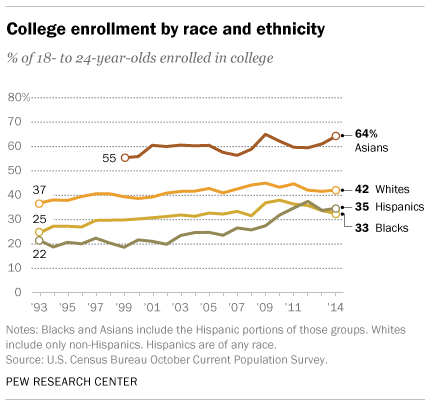
Also in the good news column, the University of California will continue to push for a greater number of underrepresented minorities; namely, Chicano/Latino students whose resident freshmen numbers rose from 2.7% to 32.3% of admitted California freshmen. In other good news, the proportion of Chicano/Latino students transferring from community colleges increased to 29.3% from 26.8% for 2015.
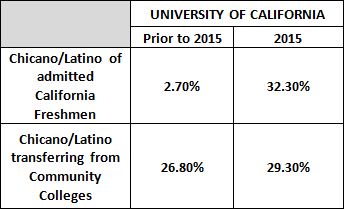
Occupations, including those in management, business, science, and art, fared better for Mexican Americans. The number of Mexican Americans filling these occupations rose from 17.4% in 2014 to 17.5% in 2015.

The total number of Hispanics filling these occupations was 16.1% in 2015, a bit lower than Mexican Americans specifically.
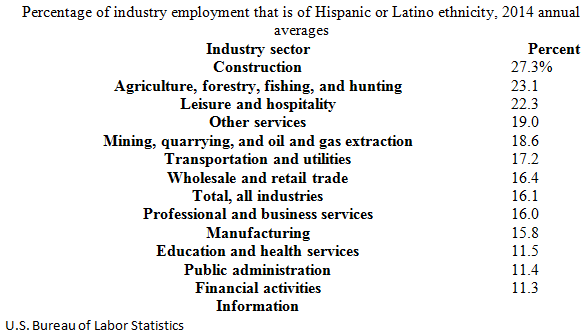
The report shows that industrial employment for Mexican Americans remained the same for 2014 and 2015 at 10.2%.
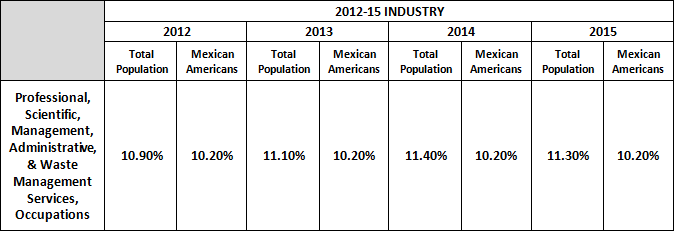
The figures for Hispanic or Latino employment for 2015 and 2016 show a healthy increase.
According to the Pew Hispanic center, “Construction, professional and business services, health services, financial services and food services…showed healthy gains.” Most of the jobs gained by native-born Hispanic workers were in manufacturing, mostly durable goods (82,000 Hispanic workers in this industry), followed by wholesale and retail trade (79,000), publishing, broadcasting, communication and information services (55,000), and construction (54,000).
Foreign-born Hispanics had the most job gains in construction (417,000), followed by business and professional services (179,000). Together, those two industries accounted for almost three-quarters (74%) of all jobs gained by foreign-born Latinos between 2005 and 2006.
The business and professional services sector, which ranges from management and technical services to janitorial, landscaping, and waste management services, is also a key employer for non-Hispanic workers. Of the total increase in employment in 2005-06, non-Hispanic workers accounted for 410,000 employees in the industry, native-born workers 327,000, and foreign-born workers 83,000.
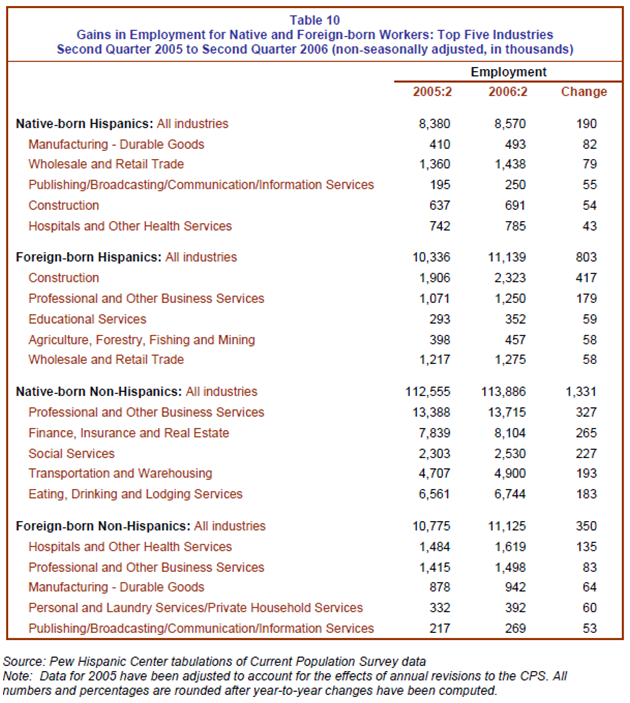
Sources
- Census Bureau, Selected Population Profile in the United States: 2015
- Pew Research Center
- University of California
- Bureau of Labor Statistics
Number of Hispanic farm operators continues to grow
WENATCHEE, Wash. — From humble beginnings in Mexico, Jesus Limon has spent a lifetime working hard for his slice of the American dream.
As a young man, he picked celery and oranges in California and tree fruit in Washington state. Twenty years ago he became one of the few Hispanic orchard owners in the Wenatchee area.
He and his wife of 40 years, Maria Luisa Limon, helped put their four sons through college and today see retirement in their not-too-distant future.
They now own 150 acres of apple trees and lease 35 acres of cherry and apple trees…
Link to article


